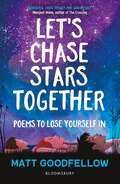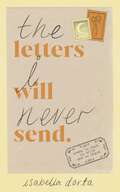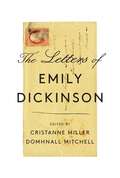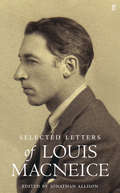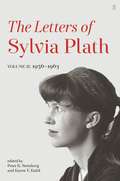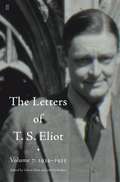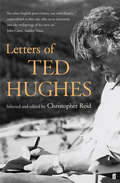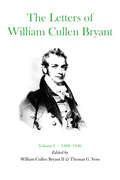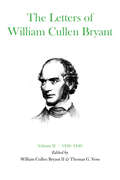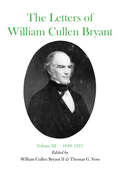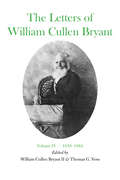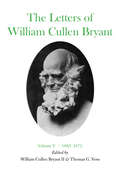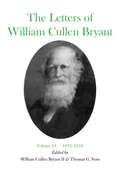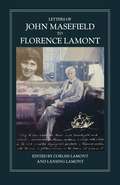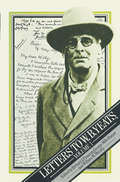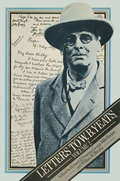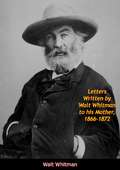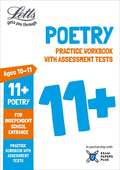- Table View
- List View
Let's Chase Stars Together: Poems to lose yourself in, perfect for 10+
by Matt GoodfellowA standout new collection of contemporary poems from prize-winning poet Matt Goodfellow, author of Bright Bursts of Colour.Perfectly reflecting the thoughts, feelings and imaginings of young people, these beautifully crafted poems are poignant, playful, heartfelt and hopeful.From friendship, family and separation to school experiences and fitting in, this moving collection touches on the relatable aspects of growing up. It delicately balances emotion with light relief and humour, and is sure to captivate any young person aged 10 and above.'Goodfellow has the knack for choosing all the right words.' The Guardian'Matt Goodfellow is a poet whose works are ideal for children.' Express
Let's Swim: Red Ditty Book 8 (Read Write Inc Series (PDF))
by Gill Munton Tim Archbold Ruth MiskinThe Red Ditty Books offer children practice in reading short decodable passages that form an important bridge between reading single words and whole sentences. They reinforce the Read Write Inc. Phonics Set 1 sounds. Each book contains three fun and humorous ditties with linked reading activities to develop accuracy, fluency and comprehension. They also prepare children for reading the longer Storybooks and Non-fiction books. Activities at the start of the books help children to practise the sounds and words they will encounter in the book. Questions to talk about at the end of the story provide an extra opportunity for developing childrens comprehension. The books are part of the Read Write Inc. Phonics programme, developed by Ruth Miskin. The programme is designed to create fluent readers, confident speakers and willing writers. It includes Handbooks, Sounds Cards, Word Cards, Storybooks, Non-fiction, Writing books and an Online resource. Read Write Inc. is fully supported by comprehensive professional development from Ruth Miskin Training.
Letter Composed During a Lull in the Fighting: Poems
by Kevin PowersShortlisted for the 2014 TS Eliot PrizeShortlisted for the 2014 Forward Prize for Best First CollectionPoetry Book Society ChoiceIn this remarkable debut poetry collection, National Book Award finalist and Iraq war veteran Kevin Powers creates a startling, affecting portrait of a life shaped by war. LETTER COMPOSED DURING A LULL IN THE FIGHTING captures the many moments that comprise a soldier's life: driving down the Texas highway; waiting for the unknown in the dry Iraq heat; writing a love letter; listening to a mother recount her dreams. Written with honesty and insight, these poems strive to make sense of war and its echoes through human experience.Just as THE YELLOW BIRDS was hailed as the 'first literary masterpiece produced by the Iraq war,' (Los Angeles Times) this collection will prove to be a powerful, enduring classic.
Letter Writing Among Poets: From William Wordsworth to Elizabeth Bishop (Edinburgh University Press)
by Jonathan EllisFifteen enlightening chapters by leading international biographers, critics and poets examine letter writing among poets in the last two hundred years. They range from Coleridge, Wordsworth, Keats and Shelley in the nineteenth-century to Eliot, Yeats, Bishop and Larkin in the twentieth. In doing so, they respond to the following questions. Who are the great letter writers of the past? Why is reading other people’s mail so addictive? What is the relationship between letter writing and other literary genres such as poetry? Divided into three sections—Contexts and Issues, Romantic and Victorian Letter Writing, and Twentieth-Century Letter Writing—the volume demonstrates that real letters still have an allure that virtual post struggles to replicate.
The Letters I Will Never Send: poems to read, to write and to share
by Isabella Dorta'these letters thus far have remained unsent, i want you to change that for me.' Embrace honesty and heal beautifully.In the letters i will never send, TikTok poet Isabella Dorta urges you to leave nothing unsaid and take comfort in moving poems on love, heartbreak, mental health and self-discovery.With beautiful line illustrations and over 100 poems written in the form of confessional letters addressed to the most influential figures in your life:Your younger selfYour future selfYour loverYour bodyYour familyand moreTake the ultimate step. Read, rip out, burn or send the letters out into the world. Write your own and share them with the people in your life. Just don't hold back!
Letters of Blood and other works in English (PDF)
by Göran Printz-Påhlson Robert ArchambeauThis collection brings together for the first time select works in English by the major Swedish modernist poet and critic Göran Printz-Påhlson. It was Printz-Påhlson who introduced poetic modernism to Scandinavia, and his essays and poems delve deeply into English, American, and continental modernist traditions. As well as "Letters of Blood", the collection includes the full text of "The Words of the Tribe", a major statement on modern poetics, in which Printz-Påhlson explores the significance of primitivism in Romanticism and Modernism, and the nature of metaphor and literary materialism. The collection also includes essays on style, irony, realism, and the relationship between historical drama and historical fiction, as well as studies of American poetry. Printz-Påhlson's poetry in English continues to explore these themes by different, often surprisingly innovative, means.
The Letters of Edward Fitzgerald, Volume 3: 1867-1876
by Edward Fitzgerald Alfred Mckinley Terhune Annabelle Burdick TerhuneBringing together more than a thousand unpublished letters as well as all the widely scattered published ones, these four volumes represent the first attempt at a complete edition of the letters of Edward Fitzgerald (1809-1883).Originally published in 1980.The Princeton Legacy Library uses the latest print-on-demand technology to again make available previously out-of-print books from the distinguished backlist of Princeton University Press. These editions preserve the original texts of these important books while presenting them in durable paperback and hardcover editions. The goal of the Princeton Legacy Library is to vastly increase access to the rich scholarly heritage found in the thousands of books published by Princeton University Press since its founding in 1905.
The Letters of Edward Fitzgerald, Volume 4: 1877-1883
by Edward Fitzgerald Alfred Mckinley Terhune Annabelle Burdick TerhuneBringing together more than a thousand unpublished letters as well as all the widely scattered published ones, these four volumes represent the first attempt at a complete edition of the letters of Edward Fitzgerald (1809-1883).Originally published in 1980.The Princeton Legacy Library uses the latest print-on-demand technology to again make available previously out-of-print books from the distinguished backlist of Princeton University Press. These editions preserve the original texts of these important books while presenting them in durable paperback and hardcover editions. The goal of the Princeton Legacy Library is to vastly increase access to the rich scholarly heritage found in the thousands of books published by Princeton University Press since its founding in 1905.
The Letters of Emily Dickinson
by Emily DickinsonThe definitive edition of Emily Dickinson’s correspondence, expanded and revised for the first time in over sixty years.Emily Dickinson was a letter writer before she was a poet. And it was through letters that she shared prose reflections—alternately humorous, provocative, affectionate, and philosophical—with her extensive community. While her letters often contain poems, and some letters consist entirely of a single poem, they also constitute a rich genre all their own. Through her correspondence, Dickinson appears in her many facets as a reader, writer, and thinker; social commentator and comedian; friend, neighbor, sister, and daughter.The Letters of Emily Dickinson is the first collected edition of the poet’s correspondence since 1958. It presents all 1,304 of her extant letters, along with the small number available from her correspondents. Almost 300 are previously uncollected, including letters published after 1958, letters more recently discovered in manuscript, and more than 200 “letter-poems” that Dickinson sent to correspondents without accompanying prose. This edition also redates much of her correspondence, relying on records of Amherst weather patterns, historical events, and details about flora and fauna to locate the letters more precisely in time. Finally, updated annotations place Dickinson’s writing more firmly in relation to national and international events, as well as the rhythms of daily life in her hometown. What emerges is not the reclusive Dickinson of legend but a poet firmly embedded in the political and literary currents of her time.Dickinson’s letters shed light on the soaring and capacious mind of a great American poet and her vast world of relationships. This edition presents her correspondence anew, in all its complexity and brilliance.
Letters of Louis MacNeice
by Louis MacNeiceLouis MacNeice is increasingly recognised as one of the greatest poets of the twentieth century, and his work has been a defining influence upon a generation of Irish poets that includes Derek Mahon, Michael Longley and Paul Muldoon.The Selected Letters is indispensable as a resource for an understanding of the intellectual culture of the mid-twentieth century. A Classics don, poet, playwright and globetrotting BBC producer, the medley and blend of MacNeice's cultural influences seems exemplary in its modernity. He kept up a significant correspondence with E. R. Dodds, Anthony Blunt and T. S. Eliot, to name but three prominent figures of the time.During his time at the BBC MacNeice witnessed many key events, including the partition of India in 1947 and the independence of the Gold Coast from Britain in 1957, and these are recorded in two long sequences to his wife, the singer Hedli Anderson.His complex relationship to Ireland and to his Irish heritages speak resonantly to contemporary debates about Irish and Northern Irish cultural identity. Finally, the Letters will do much to broaden our understanding of a vivid and often enigmatic personality whose varied life and individual charisma have often resisted explanation.
Letters of Sylvia Plath Volume II: 1956 – 1963
by Sylvia PlathSylvia Plath (1932-1963) was one of the writers that defined the course of twentieth-century poetry. Her vivid, daring and complex poetry continues to captivate new generations of readers and writers. In the Letters, we discover the art of Plath's correspondence. Most has never before been published, and it is here presented unabridged, without revision, so that she speaks directly in her own words. Refreshingly candid and offering intimate details of her personal life, Plath is playful, too, entertaining a wide range of addressees, including family, friends and professional contacts, with inimitable wit and verve.The letters document Plath's extraordinary literary development: the genesis of many poems, short and long fiction, and journalism. Her endeavour to publish in a variety of genres had mixed receptions, but she was never dissuaded. Through acceptance of her work, and rejection, Plath strove to stay true to her creative vision. Well-read and curious, she simultaneously offers a fascinating commentary on contemporary culture.Leading Plath scholar Peter K. Steinberg and Karen V. Kukil, editor of The Journals of Sylvia Plath 1950-1962, provide comprehensive footnotes and an extensive index informed by their meticulous research. Alongside a selection of photographs and Plath's own drawings, they masterfully contextualise what the pages disclose.This selection of later correspondence witnesses Plath and Hughes becoming major, influential contemporary writers, as it happened. Experiences recorded include first books and other publications; teaching; committing to writing full-time; travels; making professional acquaintances; settling in England; building a family; and buying a house. Throughout, Plath's voice is completely, uniquely her own.
Letters of T. S. Eliot Volume 7: 1934–1935, The (Letters of T. S. Eliot #7)
by T. S. EliotT. S. Eliot's career as a successful stage dramatist gathers pace throughout the fascinating letters of this volume. Following his early experimentation with the dark comedy Sweeney Agonistes (1932), Eliot is invited to write the words of an ambitious scenario sketched out by the producer-director E. Martin Browne (who was to direct all of Eliot's plays) for a grand pageant called The Rock (1934). The ensuing applause leads to a commission from the Bishop of Chichester to write a play for the Canterbury Festival, resulting in the quasi-liturgical masterpiece of dramatic writing, Murder in the Cathedral (1935). A huge commercial success, it remains in repertoire after eighty years.Even while absorbed in time-consuming theatre work, Eliot remains untiring in promoting the writers on Faber's ever broadening lists - George Barker, Marianne Moore and Louis MacNeice among them. In addition, Eliot works hard for the Christian Church he has espoused in recent years, serving on committees for the Church Union and the Church Literature Association, and creating at Faber & Faber a book list that embraces works on church history, theology and liturgy. Having separated from his wife Vivien in 1933, he is anxious to avoid running into her; but she refuses to comprehend that her husband has chosen to leave her and stalks him across literary society, leading to his place of work at the offices of Faber & Faber. The correspondence draws in detail upon Vivien's letters and diaries to provide a picture of her mental state and way of life - and to help the reader to appreciate her thoughts and feelings.
Letters of T. S. Eliot Volume 8: 1936–1938 (Letters of T. S. Eliot)
by T. S. EliotEliot is called upon to become the completely public man. He gives talks, lectures, readings and broadcasts, and even school prize-day addresses. As editor and publisher, his work is unrelenting, commissioning works ranging from Michael Roberts's The Modern Mind to Elizabeth Bowen's anthology The Faber Book of Modern Stories. Other letters reveal Eliot's delight in close friends such as John Hayward, Virginia Woolf and Polly Tandy, and his colleagues Geoffrey Faber and Frank Morley, as well as his growing troupe of godchildren - to whom he despatches many of the verses that will ultimately be gathered up in Old Possum's Book of Practical Cats (1939). The volume covers his separation from first wife Vivien, and tells the full story of the decision taken by her brother, following the best available medical advice, to commit her to an asylum - after she had been found wandering in the streets of London. All the while these numerous strands of correspondence are being played out, Eliot struggles to find the time to compose his second play, The Family Reunion (1939), which is finally completed in 1938.
Letters of Ted Hughes
by Ted HughesAt the outset of his career Ted Hughes described letter writing as 'excellent training for conversation with the world', and he was to become a prolific master of this art. This selection begins when Hughes was seventeen, and documents the course of a life at once resolutely private but intensely attuned to others. It is a fascinatingly detailed picture of a mind of genius as it evolved through an incomparably eventful life and career.
The Letters of William Cullen Bryant: Volume I, 1809–1836
by William Cullen BryantThis is the only collection ever made of Bryant's letters, two-thirds of which have never before been printed. Their publication was foreseen by the late Allan Nevin as "one of the most important and stimulating enterprises contributory to the enrichment of the nation's cultural and political life that is now within range of individual and group effort.William Cullen Bryant (1794–1878) was America's earliest national poet. His immediate followers—Longfellow, Poe, and Whitman—unquestionably began their distinguished careers in imitation of his verses. But Bryant was even more influential in his long career as a political journalist, and in his encouragement of American art, from his lectures at the National Academy of Design in 1828 to his evocation of the Metropolitan Museum of Art in 1870. Between the appearance of his first major poem, "Thanatopsis," in 1817, and his death sixty-one years later at the age of eight-three, Bryant knew and corresponded with an extraordinary number of eminent men and women. More than 2,100 of his know letters have already been recovered for the present edition.When William Cullen Bryant signed the first of 314 letters in the present volume, in 1809, he was a frail and shy farm boy of fourteen who had nonetheless already won some fame as the satirist of Thomas Jefferson. When he wrote the last, in 1836, he had become the chief poet of his country, the editor of its principal liberal newspaper, and the friend and collaborator of its leading artists and writers. His collected poems, previously published at New York, Boston, and London, were going into their third edition. His incisive editorials in the New York Evening Post were affecting the decisions of Andrew Jackson's administration. His poetic themes were beginning to find expression in the landscape paintings of Robert Weir, Asher Durand, and Thomas Cole.The early letters gathered here in chronological order give a unique picture of Cullen Bryant's youth and young manhood: his discipline in the classics preparatory to an all-too-brief college tenure; his legal study and subsequent law practice; the experiments with romantic versification which culminated in his poetic masterpieces, and those with the opposite sex which led to his courtship and marriage; his eager interest in the politics of the Madison and Monroe Presidencies, and his subsequent activities as a local politician and polemicist in western Massachusetts; his apprenticeship as magazine editor and literary critic in New York City, from which his later eminence as journalist was the natural evolution; the lectures on poetry and mythology which foreshadowed a long career as occasional orator; the collaboration in writing The Talisman, The American Landscape, and Tales of Glauber-Spa, and in forming the National Academy of Design, and the Sketch Club, which brought him intimacy with writers, artists, and publishers; his first trip to the Aemrican West, and his first long visit to Europe, during which he began the practice of writing letters to his newspaper which, throughout nearly half a century, proved him a perceptive interpreter of the distant scene to his contemporaries.Here, in essence, is the first volume of the autobiography of one whom Abraham Lincoln remarked after his first visit to New York City in 1860, "It was worth the journey to the East merely to see such a man." And John Bigelow, who of Bryant's many eulogists knew him best, said in 1878 of his longtime friend and business partner, "There was no eminent American upon whom the judgment of his countrymen would be more immediate and unanimous. The broad simple outline of his character and career had become universally familiar, like a mountain or a sea."
The Letters of William Cullen Bryant: Volume II, 1836–1849
by William Cullen BryantThe second volume of William Cullen Bryant's letters opens in 1836 as he has just returned to New York from an extended visit to Europe to resume charge of the New York Evening Post, brought near to failure during his absence by his partner William Leggett's mismanagement. At the period's close, Bryant has found in John Bigelow an able editorial associate and astute partner, with whose help he has brought the paper close to its greatest financial prosperity and to national political and cultural influence.Bryant's letters lf the years between show the versatility of his concern with the crucial political, social, artistic, and literary movements of his time, and the varied friendships he enjoyed despite his preoccupation with a controversial daily paper, and with the sustenance of a poetic reputation yet unequaled among Americans. As president of the New York Homeopathic Society, in letters and editorials urging widespread public parks, and in his presidency of the New York Society for the Abolition of the Punishment of Death, he gave attention to public health, recreation, and order. He urged the rights of labor, foreign and religious minorities, and free African Americans; his most powerful political effort of the period was in opposition to the spread of slavery through the conquest of Mexico. An early commitment to free trade in material goods was maintained in letters and editorials, and to that in ideas by his presidency of the American Copyright Club and his support of the efforts of Charles Dickens and Harriet Martineau to secure from the United States Congress and international copyright agreement.Bryant's first visit to Great Britain came at the height of his poetic and journalistic fame in 1845, bringing him into cordial intimacy with members of Parliament, scientists, journalists, artists, and writers. In detailed letters to his wife, published here for the first time, he describes the pleasures he took in breakfasting with the literary patron Samuel Rogers and the American minister Edward Everett, boating on the Thames with artists and with diarist Henry Crabb Robinson, spending an evening in the home of Leigh Hunt, and calling on the Wordsworths at Rydal Mount as well as in the distinctions paid him at a rally of the Anti-Corn-Law League in Covent Garden Theatre, and at the annual meeting in Cambridge of the British Association for the Advancement of Science.Equally fresh are most of the letters to prominent Americans, many of them his close friends, such as the two Danas, Bancroft, Cole, Cooper, Dewey, Dix, Downing, Durand, Forrest, Greenough, Irving, Longfellow, Simms, Tilden, Van Buren, and Weir. His letters to the Evening Post recounting his observations and experiences during travels abroad and in the South, West, and Northeast of the United States, which were copied widely in other newspapers and praised highly by many of their subscribers, are here made available to the present-day reader.
The Letters of William Cullen Bryant: Volume III, 1849–1857
by William Cullen BryantDuring the years covered in this volume, Bryant traveled more often and widely than at any comparable period during his life. The visits to Great Britain and Europe, a tour of the Near East and the Holy Land, and excursions in Cuba, Spain, and North Africa, as well as two trips to Illinois, he described in frequent letters to the Evening Post. Reprinted widely, and later published in two volumes, these met much critical acclaim, one notice praising the "quiet charm of these letters, written mostly from out-of-the-way places, giving charming pictures of nature and people, with the most delicate choice of words, and yet in the perfect simplicity of the true epistolary style."His absence during nearly one-fifth of this nine-year period reflected the growing prosperity of Bryant's newspaper, and his confidence in his editorial partner John Bigelow and correspondents such as William S. Thayer, as well as in the financial acumen of his business partner Isaac Henderson. These were crucial years in domestic politics, however, and Bryant's guidance of Evening Post policies was evident in editorials treating major issues such as the Compromise of 1850, the Fugitive Slave Law, the Kansas-Nebraska Bill, the rise of the Republican Party, and the Dred Scott Decision, as well as in his correspondence with such statesmen as Salmon P. Chase, Hamilton Fish, William L. Marcy, Edwin D. Morgan, and Charles Sumner. His travel letters and journalistic writings reflected as well his acute interest in a Europe in turmoil. In France and Germany he saw the struggles between revolution and repression; in Spain he talked with journalists, parliamentary leaders, and the future president of the first Spanish republic; in New York he greeted Louis Kossuth and Giuseppe Garibaldi.Bryant's close association with the arts continued. He sat for portraits to a dozen painters, among them Henry P. Gray, Daniel Huntington, Asher Durand, Charles L. Elliott, and Samuel Laurence. The landscapists continued to be inspired by his poetic themes. Sculptor Horatio Greenough asked of Bryant a critical reading of his pioneering essays on functionalism. His old friend, the tragedian Edwin Forrest, sought his mediation in what would become the most sensational divorce case of the century, with Bryant and his family as witnesses. His long advocacy of a great central park in New York was consummated by the legislature. And in 1852, his eulogy on the life of James Fenimore Cooper became the first of several such orations which would establish him as the memorialist of his literary contemporaries in New York.
The Letters of William Cullen Bryant: Volume IV, 1858–1864
by William Cullen BryantThe years just before and during the Civil War marked the high point of Bryant's influence on public affairs, which had grown steadily since the Evening Post had upheld the democratic Jacksonian revolution of the 1830s. A founder of the Free Soil Party in 1848 and the Republican Party in 1856, Bryant was lauded in 1857 by Virginia anti-slavery leader John Curtis Underwood, who wrote to Eli Thayer, "What a glory it would be to our country if it could elect this man to the Presidency-the country not he would be honored & elevated by such an event."In 1860 Bryant helped secure the Presidential nomination for Abraham Lincoln, and was instrumental in the choice of two key members of his cabinet, Salmon Chase as Secretary of the Treasury, and Gideon Welles as Secretary of the Navy. During disheartening delays and defeats in the early war years, direct communications from Union field commanders empowered his editorial admonitions to such a degree that the conductor of a national magazine concluded that the Evening Post's "clear and able political leaders have been of more service to the government of this war than some of its armies."Bryant's correspondence with statesmen further reflects the immediacy of his concern with military and political decisions. There are thirty-five known letters to Lincoln, and thirty-two to Chase, Welles, war secretary Stanton, and Senators Fessenden, Morgan, and Sumner.This seven-year passage in Bryant's life, beginning with his wife's critical illness at Naples in 1858, concludes with a unique testimonial for his seventieth birthday in November 1864. The country's leading artists and writers entertained him at a "Festival" in New York's Century Club, giving him a portfolio of pictures by forty-six painters as a token of the "sympathy" he had "ever manifested toward the Artists," and the "high rank" he had "ever accorded to art." Poets Emerson, Holmes, Longfellow, Lowell, and Whittier saluted him in prose and verse. Emerson saw him as "a true painter of the face of this country"; Holmes, as the "first sweet singer in the cage of our close-woven life." To Whittier, his personal and public life sounded "his noblest strain." And in the darkest hours of the war, said Lowell, he had "remanned ourselves in his own manhood's store," had become "himself our bravest crown."
The Letters of William Cullen Bryant: Volume V, 1865–1871
by William Cullen BryantOn April 26, 1865, as Abraham Lincoln's funeral cortege paused in Union Square, New York, before being taken by rail to Springfield, Illinois, William Cullen Bryant listened as his own verse elegy for the slain president was read to a great concourse of mourners by the Reverend Samuel Osgood. Only five years earlier and a few blocks downtown, at Cooper Union, Bryant had introduced the prairie candidate to his first eastern audience. There his masterful appeal to the conscience of the nation prepared the way for his election to the presidency on the verge of the Civil War. Now, Bryant stood below Henry Kirke Brown's equestrian statue of George Washington, impressing Osgood as if he were "the 19tth Century itself thinking over the nation and the age in that presence." Bryant's staunch support of the Union cause throughout the war, and of Lincoln's war efforts, no less than his known influence with the president, led several prominent public figures to urge that he write Lincoln's biography. Oliver Wendell Holmes wrote him, "No man combines the qualities for his biographer so completely as yourself and the finished task would be a noble crown to a noble literary life." But Bryant declined, declaring his inability to record impartially critical events in which he had taken so central a part. Furthermore, while preoccupied with the editorial direction of the New York Evening Post, he was just then repossessing and enlarging his family's homestead at Cummington, Massachusetts, where he hoped his ailing wife might, during long summers in mountain air, regain her health. But in July 1866, Frances died of recurrent rheumatic fever, and, Bryant confessed to Richard Dana, he felt as "one cast out of Paradise." After France's death Bryant traveled with his daughter Julia for nearly a year through Great Britain and the Continent, where he met British statesman and novelist Edward Bulwer Lytton and French literary critic Hyppolyte Taine, renewed his friendship with Spanish poet Carolina Coronado, Italian liberator Giuseppe Garibaldi, and British and American artists, and visited the family of the young French journalist Georges Clemenceau, as well as the graves of earlier acquaintances Francis Lord Jeffrey and Elizabeth Barrett Browning. In his spare moments Bryant sought solace by beginning the translation of Homer, and Longfellow had found relief after his wife's tragic death by rendering into English Dante's Divine Comedy. Home again in New York, Bryant bought and settled in a house at 24 West 16th Street which would be his city home for the rest of his life. Here he completed major publications, including the Iliad and Odyssey of Homer and an exhaustive Library of Poetry and Song, and added to published tributes to earlier friends, such as Thomas Cole, Fenimore Cooper, and Washington Irving, memorial discourses on Fitz-Greene Halleck and Gulian Verplanck. In addition to his continued direction of the New York Homeopathic Medical college and the American Free Trade League, he was elected to the presidency of the Williams College Alumni Association, the International Copyright Association, and the Century Association, the club of artists and writers of which, twenty years earlier, he had been a principal founder and which he would direct for the last decade of his life.
The Letters of William Cullen Bryant: Volume VI, 1872–1878
by William Cullen BryantIn January 1872, Bryant traveled to Mexico City, where he was greeted warmly by President Benito Juarez; on this and other occasions he was feted for the Evening Post's sturdy condemnation in 1863 of the abortive invasion of Mexico, which was freshly remembered there. AT the close of his visit a local newspaper remarked that the "honors and hospitality which were so lavishly and generously conferred upon him were the spontaneous outpouring of a grateful people, who had not forgotten that when Mexico was friendless Mr. Bryant became her friend." Returning in April through New Orleans and up the Mississippi by steamboat to Cincinnati, he was greeted at a public reception by Governor Rutherford Hayes, who was pleased by his "winning and lovable" manners and "pithy" anecdotes.That spring Bryant built a library for his birthplace, Cummington, stocking it with several thousand books procured for him by the publisher George Palmer Putnam in New York and London. The following year, after the last of his many travels - this time a revisit to South Carolina and Florida - he made a similar gift to Roslyn. These benefactions won him honorary membership in the newly formed American Library Association, and an invitation to open a library at Princeton University, which made him an honorary doctor of letters. Ultimately, in the final year of his life, his plans for the Bryant Library at Cummington, solicited from the White House by President Hayes, provided the basic design for the first presidential library in the country - that established by Hayes in Fremont, Ohio.An improbable by-product of the presidential race in 1872 was a proposal by leading journalists that Bryant become -in his seventy-eighth year - a candidate to oppose President Grant and his challenger for the Republican nomination, the mercurial editor of the New York Tribune, Horace Greeley. Bryant's immediate refusal to take the suggestion seriously was succinct, and tinged with humor. It was impossible, he declared in his newspaper, that he should receive the nomination, and "equally impossible," if it were offered, that he should "commit the folly of accepting it." Four years later he was distressed at being unable to switch his journal's support of the Republican candidate Hayes to the Democratic candidate, his old companion in political reform, Samuel Jones Tilden.As Bryant approached and entered his eighties, his writing and public speaking continued without slackening. Between 1872 and 1878 he published his collected Orations and Addresses, edited a revision of his anthology of poetry and two volumes of landscape sketches, Picturesque America, co-authored a four-volume Popular History of the United States, and undertook to co-edit a three-volume set of Shakespeare's plays, while also producing long monographs on several seventeenth-century English poets. He dedicated statues of Shakespeare, Walter Scott, and Fitz-Green Halleck in Central Park, and spoke elsewhere on Robert Burns, Benjamin Franklin, Goethe, and Shakespeare, gave speeches on Mexico and "National Honesty," and presided over the founding of the State Charities Aid Association. He was honored in Albany at receptions by each house of the legislature. For his eightieth birthday, his life's work was celebrated in silver on a Tiffany vase given him by admirers throughout the country.Bryant's last public act was to unveil, in Central Park, his brainchild of nearly a half century earlier: a bust of the Italian patriot Giuseppe Mazzini. Here, after exhaustion under the June sun, he fell and suffered a massive concussion followed by a stroke, which led to his death a fortnight later in his eighty-fourth year. A period of virtual national mourning preceded his funeral and his burial beside his wife at Roslyn. At one of many memorial services, a eulogist exclaimed, "The broad outline of his character had become universally familiar, like a mountain or a sea. Whoever saw Bryant saw America."
Letters to W. B. Yeats (The\collected Works Of W. B. Yeats Ser.)
by Richard J Finneran George Mills Harper William M MurphydLetts 11+ Poetry - Practice Workbook With Assessment Tests: For Independent School Entrance (PDF)
by Letts Common Letts Common EntranceSuitable for the 2020 tests. However you like to learn, Letts will get you through! Get practising for the 11+ Independent School Entrance Exams with the Letts 11+ Poetry Practice Workbook with Assessment Tests. This incredibly simple yet effective poetry workbook is divided into three easy sections: Understanding a Poem, Assessment, then Example Answers and Guidance.
